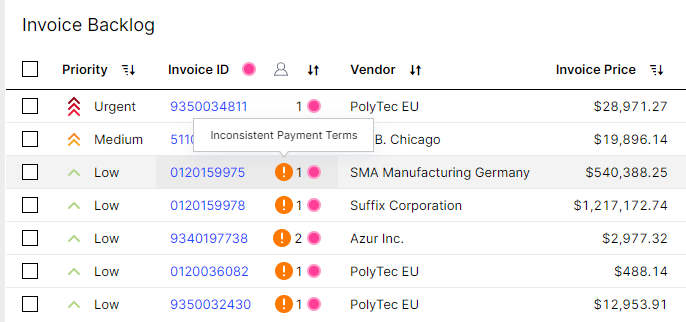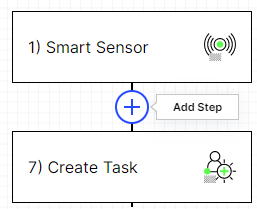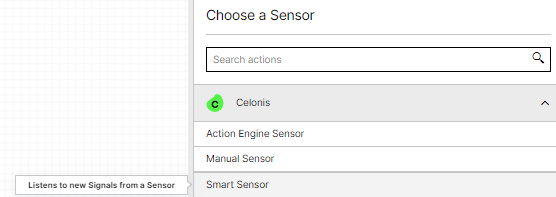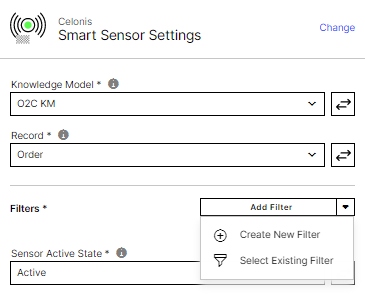Create Alerts
Alerts allow to highlight all incidents of a certain kind. Whenever a data object meets the respective filter condition, this is pointed out by an alert:
 |
Follow the Step by Step Guide below to learn about the setup of alerts.
Optional: If you want to involve the business user with Tasks on the objects which have alerts on them, you also have to complete this guide. If you have done so, you can directly jump to Step 3 here and add the Alert Action right after the Smart Sensor and before the Task creation:
 |
Note
Check the "Note" sections in this guide! They highlight parts of the configuration that potentially lead to errors when not done properly.
Step by Step Guide
Step 1: Create a new Skill in your package
Define a Skill name.
The Skill key will be automatically created. The Skill key is unique and can be used to refer to a specific Skill throughout the Celonis Platform.
Optional: Add a Skill description.
Click on "Create".
 |
Step 2: Set up the Smart Sensor as a trigger of the Alert
The purpose of a Smart Sensor is to react automatically upon a specified data incident, also called Signal, which can be defined in the filter statement(s).
In the Skill that you created in Step 1, click on "Add a Sensor".
Select "Smart Sensor" which you can find in the "Celonis" category.
 |
Select the inputs for your Smart Sensor (for a detailed description of the configuration see Celonis Smart Sensor:
Knowledge Model in which you defined the filter.
Record to which the Smart Sensor is related.
Add one or several filter(s)
Choose the State of the Smart Sensor to be "Active" if it to constantly run in the background.
Click on "Save".
Click on "Add Next Step".
 |
Step 3: Add the Alert Action
Choose the "Create Alert" Action in the Celonis section.
Add a Description which will be displayed when hovering over the alert icon in the table.
Click "Save".
Step 4: Testing and publishing the Alert
When you have defined all required inputs, click on "Test" to monitor the Test Execution Logs. This will only be possible if all the required inputs are defined.
Edit the Skill where appropriate and click "Publish" to execute the Skill for all existing incidents.
Note
Note 1: The Alert creation is only completed when the Skill is published - saving is not enough if you want the Skill to be active.
Note 2: Once a Skill is published the Smart Sensor checks for new incidents constantly and executes the Alert creation automatically if applicable. New incidents can occur due to a data model reload or due to updated filter conditions in the Knowledge Model (see Step 2). Saving the modified Knowledge Model counts as an update - you don't necessarily have to publish it.
Step 5: Monitor and Edit your Alert
Monitor the Execution and the Sensor Logs of your Alert by clicking on "Logs":
The Execution Logs show how often and when the Skill was executed and which path was taken (fields in green).
The Sensor Logs show how many new incidents were detected by the Smart Sensor, when they were detected and if they were resolved.
Edit your Skill by clicking on "Edit" and "Publish" again once all changes are made.
Please ensure to save and publish both your Smart Sensor and Knowledge Model after updating filter conditions in the Knowledge Model.
Note
Changes in the Alert description will only be applied to Alerts triggered by future incidents. An alert will not be triggered a second time for the same incident - even if you "publish" it. However, you have the option to review your Alert description adjustments by manually resetting your Skill. For more details, see FAQ - 1 below.
Sensor Logs:
 |
Step 6: Displaying Alerts
The created alerts will be displayed on all tables of the record type which you referenced in the Smart Sensor configuration. If you haven't done so yet, you can create a new View or edit an existing one and set up a table for the respective record. The alerts will be automatically displayed on it.
 |
Frequently asked questions about creating alerts
How can I review my Alert description adjustments when there are no new signals currently? In general, changed Skill configurations will only apply to future incidents. However, you can pretend new signals by manually resetting your Skill. First, adjust the filter condition of your sensor in the Knowledge Model (see Step 2) so that no signals are found anymore. A good way to do so is to add a wrong condition such as "0 = 1" to the PQL query. Click "Save". Now, you can reset the filter statement to the initial state. The Smart Sensor will detect new incidents and therefore trigger new Skill executions with the adjusted configuration.
Why are my signals not updating? Currently, the number of active signals per Smart Sensor is capped at 10,000. As a result of this, new alerts will not be displayed until existing alerts are resolved.
Resetting your Skill by adding a wrong condition:
filters:
- id: INCONSISTENT_PAYMENT_TERMS_SENSOR_FILTER
displayName: Inconsistent Payment Terms for CC Sinolec US sensor filter
pql: FILTER "BSEG"."ZTERM"<>"EKKO"."ZTERM" AND "BSEG"."BUKRS" =''A004'' AND 0 = 1
global: false
type: FILTER